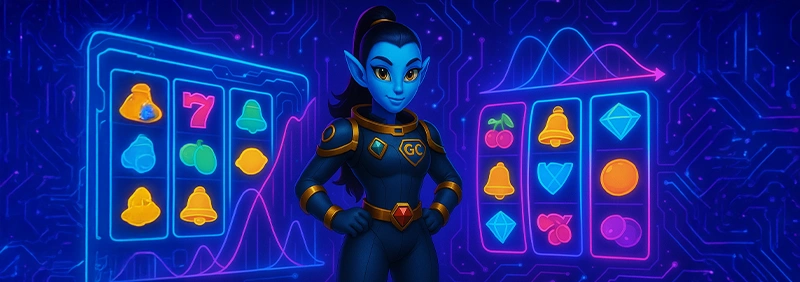Home > Casino Lab > Science of Slots > Probability in Slots: How Symbols and Reel Sizes Impact Outcomes
Probability in Slots: How Symbols and Reel Sizes Impact Outcomes
Slot machines may look like games of pure luck, but behind every spin lies a system of probabilities and mathematical design.
The symbols on the reels, the number of reels, and the layout of paylines all work together to determine how often players win—and how big those wins can be. Understanding these mechanics is essential for anyone who wants to see beyond the flashing lights and appreciate the mathematics that drive slot outcomes.

The Basics of Probability in Slot Machines
At its core, probability in slots is about the likelihood of a specific combination of symbols landing on the reels. Each reel contains a certain number of positions (known as “stops”), and each symbol has a defined chance of appearing. For example, in a three-reel slot with 10 symbols per reel, the probability of hitting a specific three-symbol combination is 1 in 1,000.
Modern slots complicate this further by using virtual reels. These allow developers to assign different probabilities to different symbols, making rare icons like jackpots appear less frequently than common ones. This system lets casinos balance the excitement of potential big wins with the need to maintain profitabilit
How Reel Sizes Influence Outcomes
The size of the reels—the number of symbols on each—directly affects the odds of winning. Slots with fewer symbols per reel make it easier to hit combinations, while larger reels create rarer but potentially more rewarding outcomes. For instance, a five-reel slot with dozens of symbols per reel introduces thousands of possible combinations, lowering the odds of hitting specific outcomes but creating space for larger payouts and more complex bonus features.
This is why reel size is tied closely to volatility. Games with large reel sets and rare symbols tend to have high volatility, producing fewer but bigger wins. Smaller reel sets, by contrast, lean toward low volatility and frequent, modest payouts.
The Role of Symbols and Paylines
Symbols are the building blocks of probability in slots. Common symbols, such as fruits or letters, are designed to appear often, delivering small rewards that keep the game engaging. Rare symbols, like wilds, scatters, or jackpot icons, appear infrequently but unlock larger wins or special features.
Paylines multiply the complexity. In a single-line slot, only one combination matters, but in modern multi-line slots, hundreds of possible lines can be active at once. This means a single spin can produce multiple winning outcomes simultaneously. The math behind paylines, combined with symbol frequency, determines the overall payout potential of the slot.
Why Understanding Slot Probability Matters
For players, understanding how symbols and reel sizes affect outcomes helps set realistic expectations. While no strategy can beat the RNG that governs slots, knowing the mechanics provides insight into why some games feel “tight” and others feel more generous. Choosing between high-volatility, large-reel slots and low-volatility, small-reel games becomes a matter of aligning play style with risk appetite.
By 2030, as Web3 and blockchain-based slots grow, probabilities may even be made provably fair and transparent, allowing players to verify symbol frequencies and reel layouts directly on the blockchain.
Conclusion
Probability is the hidden engine behind every slot machine. The number of reels, the distribution of symbols, and the structure of paylines all shape the player experience.
While every outcome is ultimately random, understanding the math behind slots reveals why some games pay frequently and others save their rewards for rare but dramatic wins. For players, the key is not to predict outcomes but to choose slots whose probability models match their bankroll and style of play.
